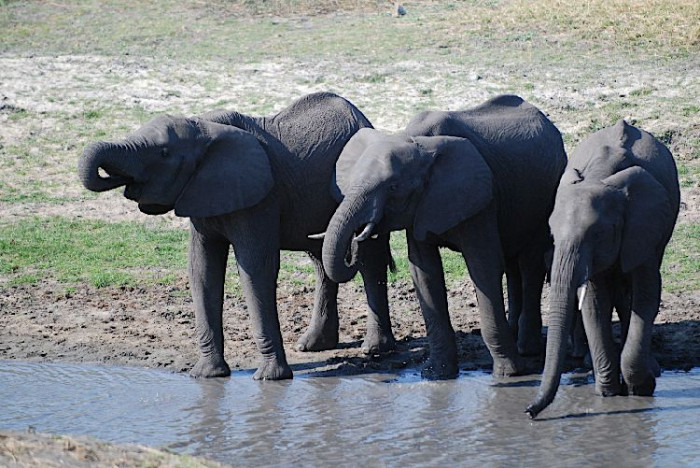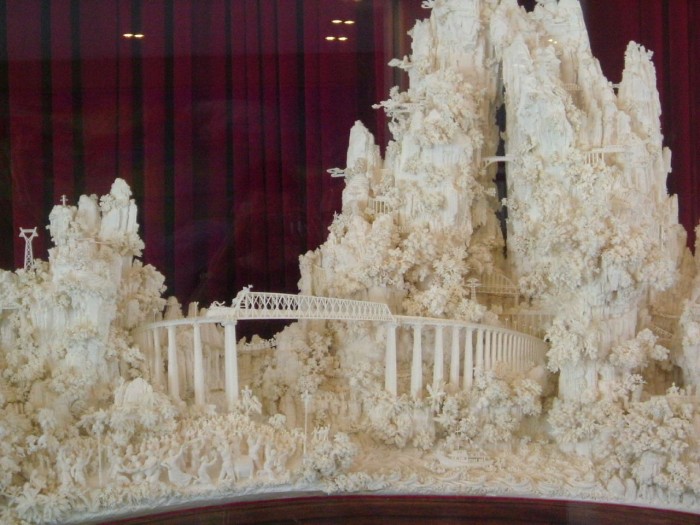 It is sadly no longer news that poachers are using heavy artillery, helicopters, and astonishingly complex international crime networks to obtain ivory. But their latest tactic is still more cruel and disturbing: This week, Zimbabwean authorities confirmed the arrest of six poachers, who killed 41 elephants in Hwange National Park by poisoning the watering holes with cyanide. They recovered 17 tusks worth $120,000, which no doubt would have been smuggled into China, the world’s leading consumer of illegal ivory. The ivory often passes through Hong Kong, where the police have seized ivory shipments worth millions of dollars. But there is simply no way that the 700 customs agents can check 60,000 cargoes that pass through Hong Kong each day, and less than 1% of them are inspected.
It is sadly no longer news that poachers are using heavy artillery, helicopters, and astonishingly complex international crime networks to obtain ivory. But their latest tactic is still more cruel and disturbing: This week, Zimbabwean authorities confirmed the arrest of six poachers, who killed 41 elephants in Hwange National Park by poisoning the watering holes with cyanide. They recovered 17 tusks worth $120,000, which no doubt would have been smuggled into China, the world’s leading consumer of illegal ivory. The ivory often passes through Hong Kong, where the police have seized ivory shipments worth millions of dollars. But there is simply no way that the 700 customs agents can check 60,000 cargoes that pass through Hong Kong each day, and less than 1% of them are inspected.
The impossibility of checking every container is understandable—what defies common sense, however, is the proliferation of countless ivory carvings for sale in Hong Kong’s antiques stores. When I was in Hong Kong this spring, I wanted to see some art for mental rejuvenation in this extraordinarily commercial city, filled with luxury stores on every street. We ducked into an antiques store on the corner, hoping to find some traditional paintings or ceramics: instead, I found myself face to face with glittering, wall-to-wall glass displays of ivory carvings. Prominently displayed in the center were a couple of huge “mammoth” tusks, intricately carved with filigree, miniature trees, cliffs, and people—priced at $210 million Hong Kong dollars, or around $30 million USD. Mammoth tusks are legally imported from Siberia, and are valued approximately equal to ivory—but shop keepers say that their customers still prefer elephant ivory, which is “more perfect because mammoth is already aged.” It is therefore hardly a deterrent to real elephant ivory sales, which was displayed all around the shop, from Bodhisattva statuettes in the millions range and miniature figurines worth mere hundreds of thousands of dollars. These ivory items are not illegal as long as they have been carved before the 1989 international trade ban on elephant ivory—but with no regulatory checks on their dates, it is anybody’s game to trade in the ivory products, whether they are technically legal or no.
An African elephant is killed and dehorned by poachers every fifteen minutes. With problem of this magnitude, a concerted effort from powerful international organizations and governments will be our only hope. First, it is logical that all sale of ivory should be banned in Hong Kong and China to close the pre-1989 loophole. As a recent TIME magazine article notes, ivory control in Hong Kong is critical as it is the major port for entry into China. Secondly, the United Nations should play more than just lip service to this crisis: Secretary Ban Ki-moon’s recent call for action from Central African governments is a step, but the UN should employ its considerable human and military resources to protect the animals at the ground level. As Secretary Ban notes, ivory trade not only is extinguishing one of our most beloved animals, but also enriching terrorist organizations and armed factions all over Africa. Ivory trade is therefore a security concern as well as an environmental issue, and fully in the interest of the United Nations to combat.

In 1974, the Chinese government gifted a huge ivory carving to the UN. The sculpture made from eight elephant tusks still stands today in the UN headquarters in New York. If the UN were serious about this crisis, they might start by returning this gift to the Chinese government and urging them to cooperate in the ivory ban efforts. But that is not likely to happen realistically.
Perhaps most importantly, in addition to sending armed peacekeeping troops and specialists to afflicted regions, the UN should also launch a marketing campaign to change the attitude of the Chinese consumers. The root of the problem is that there is an extraordinary demand for ivory in China. The growing nouveau rich in China are eager to flaunt their wealth with this traditional symbol of wealth, prestige, and power—along with bear paws and gallbladder, bones of endangered Siberian tiger, rhinoceros horns, and other animal parts. The underlying appeal for all these items is based on tradition or superstitions, not facts, and so must we change these false beliefs. It might be an advertising campaign showing the pictures of elephant remains, a social media campaign alluding to the “bad luck” of possessing something so ill-gotten, or any other creative ways to convince these people that there is no prestige in owning ivory. There is hope in that consumer mentality is fickle and liable to change—but only with active top-down effort can we hope that Africa’s watering holes do not turn into silent springs.
Opinion: Finding Peaceful Solutions in Syria
Editorial: Vegan Thing That Is Destroying the Planet
Photo: (elephants drinking) Nils Rinaldi via Flickr; (ivory sculpture) Robert Young via Flickr




